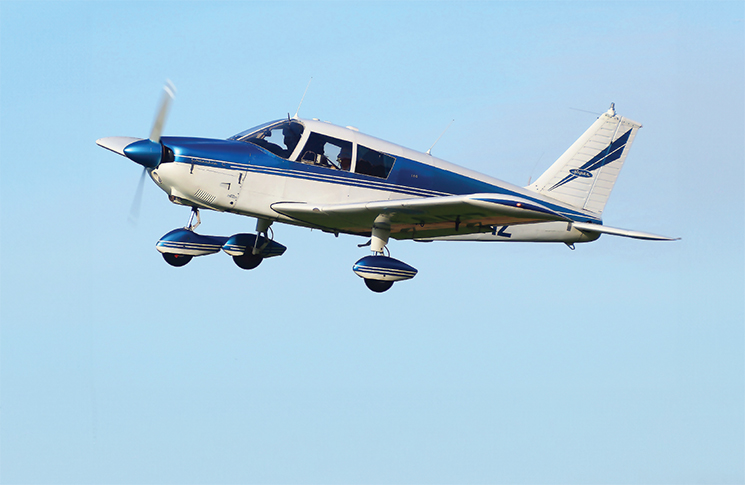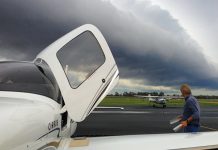A pilot learns a valuable lesson in taking responsibility and control.
Conspire –verb. 1. to agree together, especially secretly, to do something reprehensible or illegal.
That word, conspire, went through my head for days after this particular close call. It did so because it accurately described an accumulation of factors leading to the incident. And it also helped me shift blame away from things I could have done, and back onto the events themselves.
It was a blisteringly hot day in the Sydney basin. The forecast said the temperature was due to flirt with 40 °C by late afternoon. It was already climbing towards the mid-30s as my passengers and I were ready to board a Piper Cherokee at Bankstown. The plan was for a scenic flight to Katoomba and the Three Sisters in the Blue Mountains, before returning to Bankstown via Camden.
We were heavy – 3 POB, full fuel and some hefty camera bags. Knowing this, I diligently completed the weight and balance and performance charts, to find out we were just within limits. With the flight plan in hand, we headed out to the aircraft and I enjoyed showing my passengers the walk around.
The departure from Bankstown was uneventful, so I relaxed as we set course for the Blue Mountains. The Three Sisters appeared and water was glistening in the sunlight as it cascaded down the magnificent Wentworth Falls. It was one of those moments you relish as a pilot: when your passengers are beaming at the experience you are providing. With photos complete, we set course for Camden, planning a touch-and-go before heading home.
As we descended back into the Sydney basin, my thoughts turned to the Camden approach. It’s always impressive for passengers if you fly the low-level entry to the zone, following the river, and then a touch-and-go on runway 10, which is grass. I thought about the climb performance we had achieved earlier at Bankstown and decided the shorter grass runway at Camden would present no problems, especially during a touch-and-go. So, this was what I requested from ATC and they told me to proceed.
However, now that we were down low, it was clear the air had become more turbulent since we left Bankstown. We passed through areas of rising and descending air which required active altitude maintenance and my passengers were noticeably quieter than earlier.
I remember seeing a tinny on the river and being able to make out the name on the front of the boat – that is how low we were.
The approach looked great until about 300 feet when we entered a smooth, wide thermal. It wasn’t as rough as the others, almost imperceptible as we first entered it, but steadily it reduced my rate of descent and the grass runway appeared to fall away beneath me. No problem I thought – reduce power to idle, lower the nose to maintain airspeed, a little sideslipping – and we were almost back on the ideal descent path. Almost.
We landed long, floating more than I liked and eventually touched down a few metres to the right of the centre. Regained the centreline, flaps up, full power –we began to accelerate again. Slowly. Perhaps too slowly?
I looked at the ASI and the needle was creeping clockwise. Not so slowly that I thought about aborting the take-off, but slower than felt comfortable, or normal. Finally, after what felt like an eternity, we hit the magic 60 knots and I squeezed back on the yoke, teasing the Cherokee back into the air.
To say the climb performance was below par was an understatement. I checked my airspeed – 79 knots for best rate of climb – and looked ahead to the end of the runway. The trees beyond it which were getting bigger by the second.
Why was the performance so different to the conditions I had at Bankstown? I couldn’t understand it. I checked the throttle, ramming it against the stops. I realised now had to establish best angle of climb if I wanted to avoid turning the 3 of us into a statistic.
I raised the nose to the correct attitude. The airspeed reduced to 63 knots and only then did I dare look to my left – the tops of the trees next to the Nepean River passed about 50 feet below us. I remember seeing a tinny on the river and being able to make out the name on the front of the boat.That is how low we were!
Once more my eyes scanned the instruments for any sign of trouble and then I saw it – carburettor heat ‘on’. My heart sank. I reached down and flicked the lever back up and immediately things improved – the engine note picked up and the rate of climb improved. I couldn’t believe the difference an extra 100 rpm was making on this marginal day. As we climbed away and set course for Bankstown, I began to see how it happened.
The approach was normal until 300 feet and then the smooth thermal began to conspire against me. It must have chosen that specific point as it knew I always do my final checks at 300 feet, including when I turn the carby heat off.
On any other day, I would not have allowed myself to end up with such a reduced safety margin, but the density altitude was also conspiring against me. The aircraft had conspired against me too, choosing this particular flight to be close to maximum take-off weight.
Then the runway conspired against me, being short and having a grass surface, thereby adding to the take-off roll that was already extended due to the float on landing, conspiring against me…
Lessons learnt
It took a few days to realise the only real conspiracy theory was in my mind. As I mulled over my close call that day, it was becoming clear that every factor was manageable:
- I should have planned more carefully before requesting a short grass runway on a hot and humid day.
- I should have gone around early, rather than continue with an unstable approach.
- I should have initiated a best angle of climb sooner than I did.
- I shouldn’t have allowed myself to be distracted from those critical 300-foot checks.
There is a quote which says, ‘Conspiracy theories are the refuge of the disempowered.’ While this incident was a valuable lesson in how a multitude of different threats and errors can quickly escalate into an undesired aircraft state, the biggest lesson of all was coming to terms with the fact that I was empowered to manage all of them better than I did.
Controlled aerodromes
Controlled aerodromes and operations is one of the special topics on our Pilot safety hub. Refresh your knowledge.
Have you had a close call?
8 in 10 pilots say they learn best from other pilots and your narrow escape can be a valuable lesson.
We invite you to share your experience to help us improve aviation safety, whatever your role.
Find out more and share your close call here.
Disclaimer
Close calls are contributed by readers like you. They are someone’s account of a real-life experience. We publish close calls so others can learn positive lessons from their stories, and to stimulate discussion. We do our best to verify the information but cannot guarantee it is free of mistakes or errors.






Comments are closed.